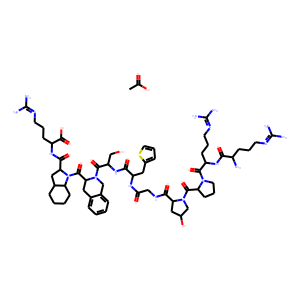| IUPAC Name | (2S)-2-[[(2S,3aS,7aS)-1-[2-[(2S)-2-[[(2S)-2-[[2-[[(2S,4R)-1-[(2S)-1-[(2S)-2-[[(2R)-2-amino-5-(diaminomethylideneamino)pentanoyl]amino]-5-(diaminomethylideneamino)pentanoyl]pyrrolidine-2-carbonyl]-4-hydroxypyrrolidine-2-carbonyl]amino]acetyl]amino]-3-thiophen-2-ylpropanoyl]amino]-3-hydroxypropanoyl]-3,4-dihydro-1H-isoquinoline-3-carbonyl]-2,3,3a,4,5,6,7,7a-octahydroindole-2-carbonyl]amino]-5-(diaminomethylideneamino)pentanoic acid;acetic acid |
| InChI | InChI=1S/C59H89N19O13S.C2H4O2/c60-37(14-5-19-67-57(61)62)48(82)72-38(15-6-20-68-58(63)64)52(86)75-22-8-18-43(75)54(88)77-30-35(80)26-44(77)50(84)70-28-47(81)71-40(27-36-13-9-23-92-36)49(83)74-41(31-79)53(87)76-29-34-12-2-1-10-32(34)24-46(76)55(89)78-42-17-4-3-11-33(42)25-45(78)51(85)73-39(56(90)91)16-7-21-69-59(65)66;1-2(3)4/h1-2,9-10,12-13,23,33,35,37-46,79-80H,3-8,11,14-22,24-31,60H2,(H,70,84)(H,71,81)(H,72,82)(H,73,85)(H,74,83)(H,90,91)(H4,61,62,67)(H4,63,64,68)(H4,65,66,69);1H3,(H,3,4)/t33-,35+,37+,38-,39-,40-,41-,42-,43-,44-,45-,46?;/m0./s1 |
| Reference | <p>
<span style="color:#000000;"><span style="font-size:12px;"><span style="font-family:arial,helvetica,sans-serif;">1.Hock, F. J., et al. "Hoe 140 a new potent and long acting bradykinin‐antagonist: in vitro studies." <i style="font-family: Arial, sans-serif; font-size: 13px;">British journal of pharmacology</i> 102.3 (1991): 769-773.<br />
2.Han, Eun D., et al. "Increased vascular permeability in C1 inhibitor–deficient mice mediated by the bradykinin type 2 receptor." <i style="font-family: Arial, sans-serif; font-size: 13px;">The Journal of clinical investigation</i> 109.8 (2002): 1057-1063.</span></span></span></p>
|

